
You can tell a lot about a person just by the content of their character, in how they treat others, and in how they interact with the world around them. Are they someone who is honest and reliable or one who is untrustworthy and a fraud? What does the character of a person tell you about their work and the standards to which they uphold themselves? Are they pursuing the truth in a logical way or are they more concerned with seeking prestige and fame? If one is considered an honest person, it is easier to trust that this is reflected in their work. If, however, they are considered dishonest, we would expect to see that quality reflected in what they put out into the world. Most would agree to take their car to the mechanic with a stellar reputation who provides quality service and a fair price over the one who has the reputation as an overpriced swindler who “fixes” one thing while breaking another. Thus, the character of a person can tell us quite a bit about the kind of work they do.
If you were to hear this description of a person, what would it tell you to expect about their work?
“…by no means always humble, selfless, ethically superior…quite the opposite.“
“...behavior and conduct in general unlikeable through much of his career. He is not a very appealing human being.“
Does this sound like a man whose character leads you to have faith in his ability to accurately represent his own work? Does this man sound trustworthy? These descriptors are of Louis Pasteur, considered the Father of Germ Theory and they come from Gerald Geison, a leading Pasteur scholar who examined a collection of notebooks that Pasteur had asked his family never to make public. Geison eventually wrote a book in 1995 titled The Private Science of Louis
Pasteur detailing his findings. The aim of the book was to present an accurate portrayal of the man and not his idealized vision of himself:
This book seeks to contribute to that larger project of revaluation-to deconstruct, as it were, the currently dominant image of Pasteur. That image was forged in a context that
Geison 1995:278
has lost much of its meaning for us-a context in which heroic biographies were used to transmit widely accepted moral verities and in which science was seen as straightforwardly useful and ‘positive’ knowledge. Even in an age in need and search of heroes, we
need no longer accept that image at face value. We need no longer perpetuate Pasteur’s image of himself.
Looking at excerpts from reviews of the book, we can gain a bit more insight into Geison’s deconstruction of Pasteur’s character:
“[A]t moments critical to his most dramatic scientific achievements Pasteur misrepresented his work so as to marginalize opponents and to gain public confidence, private sponsorship and scientific prestige” (The Economist 1995).
The science section of the New York Times commented, “Pasteur…lied about his research, stole ideas from a competitor and was deceitful in ways that would now be regarded as scientific misconduct” (Altman 1995)
Nature said, “[Pasteur] is, in short, the perfect anti-hero for our anti-heroic age” (Bynum 1995)
“Which famous scientist was secretive and deceptive, unethical in his conduct with patients, choosy in selecting experimental results, difficult to work with, selfish and even cruel towards opponents, and possessive to the point of absurdity with his laboratory records?” (The New Scientist)
From the New England Journal of Medicine “In some cases, Pasteur’s behavior may be termed showmanship, but in others it clearly amounted to deception” (Fee 1995).”
doi: 10.1086/393744.
These are clearly descriptions of a man who manipulated the data from his experiments in order to obtain the desired results so that he could gain the accompanying prestige. Based on this picture, Pasteur’s character isn’t a very promising one nor would it be easy to trust the results of the experiments of the man described above. However, this article is not meant as an attack on Pasteur’s personality. It is to show that the unfavorable qualities he possessed found their way into his research and ultimately influenced the outcomes of his results.
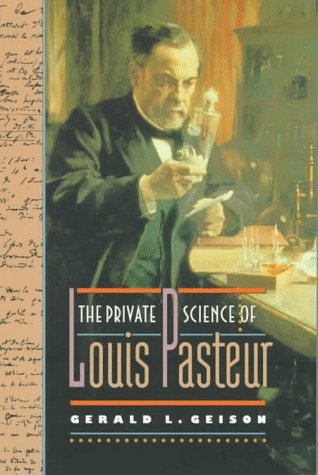
Before Geison’s book was released in 1995, a 1993 article from the Washington Post highlighted his research and provided some more detail as to what Geison had uncovered. Excerpts from this article help to show some of Pasteur’s unethical and unscientific conduct during a demonstration of his anthrax vaccine as well as in his vaccination of a 9-year-old boy presumed to have had rabies:
LOUIS PASTEUR AND QUESTIONS OF FRAUD
“Louis Pasteur’s achievements rank him as one of the greatest scientists of all time. But in at least two significant cases, the 19th century French researcher apparently lied about his scientific methods, appropriated an idea from a competitor and conducted human experiments that would be considered unethical then as well as today.
Princeton history professor Gerald L. Geison, a leading Pasteur scholar, unearthed “two examples of what might be called scientific misconduct” in the public trial of a vaccine against deadly anthrax disease in sheep and the vaccination of a young boy against the lethal disease rabies.
Geison concluded that, despite his monumental contributions to medicine, Pasteur would “not have passed muster with Congress” if his scientific methods were scrutinized today.”
“Geison noted that Pasteur’s notebooks revealed that he had regularly “massaged” or manipulated raw data in order to fit his own preconceived ideas. This conforms, he said, with other historical studies that have shown that even among prominent scientists “there are always discrepancies between the private record and published results.”
“Behind Pasteur’s carefully cultivated public image, however, were chinks in his armor that lay hidden in elaborate scientific notebooks and other private documents on his life’s work. He carefully instructed his family never to show them to anyone, a request that was honored until the private manuscripts were finally given to the Bibliotheque Nationale in Paris by his last male descendant and became available to scholars in the early 1970s.
Geison said the vast collection included 30 bound volumes of unpublished correspondence, lecture notes and school records and more than 100 laboratory notebooks amounting to perhaps 10,000 pages covering Pasteur’s 40-year scientific career. It took a year just to learn to read Pasteur’s pinched handwriting, but the Princeton professor eventually found “ethically dubious conduct” in Pasteur’s famous anthrax and rabies vaccines.
The anthrax episode began with an article in which Pasteur announced a new vaccine could be produced by exposing the deadly anthrax organism to oxygen to reduce its strength. Then, he said, the organism was suitable for vaccination to protect animals from the infectious disease. He impulsively accepted a public challenge to demonstrate its effectiveness, despite the private consternation of his own colleagues and his own inner doubts that his vaccine was really ready for use.
In May 1881, in the French village of Pouilly-le-Fort, Pasteur launched a “bold public demonstration” of the vaccine in an experiment involving 50 sheep. When it was successful, he returned in June “to bask in the applause” from an appreciative crowd of reporters and dignitaries. “It was a moment of high drama,” said Geison.
According to a footnote in one of his lab notebooks, however, Pasteur had used another vaccine approach in which the anthrax was treated with chemicals to weaken it rather than being exposed to oxygen. Using this approach, suggested Geison, Pasteur “pushed aside a rival,” Jean-Joseph Henri Toussaint, an obscure veterinarian who developed the chemically treated vaccine first and had visited Pasteur’s laboratory to discuss it.
“Pasteur deliberately deceived the public and scientific community about the precise nature of the vaccine he used,” said Geison, calling it a “clear case of scientific misconduct . . . He knew full well he was lying.”
“Another example of questionable conduct concerned the first human use of the rabies vaccine. On July 5, 1885, a 9-year-old Alsatian peasant, Joseph Meister, showed up unannounced at Pasteur’s door. He had been bitten 14 times by a dog with classic signs of rabies. While young Meister would not know for several weeks if he were infected, Pasteur decided to administer his new rabies vaccine in hopes of saving the youth’s life.
Meister did survive, and three months later Pasteur published a paper reporting that his rabies vaccine had previously been tested on 50 dogs without a single failure before he used it to treat the boy. But Geison discovered through the notebooks that this was, “to put it charitably, a very misleading account.”
In fact, Pasteur had extensively tested a vaccine on dogs that used an approach that was exactly the reverse of the one used on Meister. The method he used on the boy involved injections of successively stronger doses of rabies virus. This approach was being tested on laboratory dogs at the time the human experiment was attempted, but Pasteur had no conclusive animal results to show that the technique worked.
“There was no experimental evidence for his published claims about the extent of the safety and efficacy of the vaccine in animals before the human rabies trial,” said Geison.”
“Pasteur’s message for contemporary science, Geison argued, was to puncture the “hopelessly misleading” image of science as “simply objective and unprejudiced,” a myth that scientists have perpetuated in order to advance their work and attain a “privileged status.”
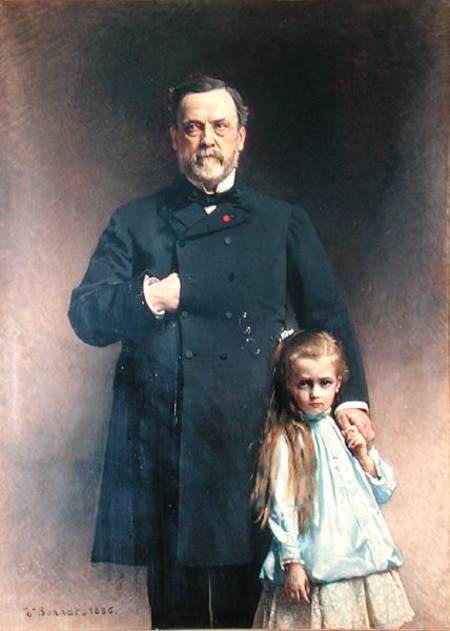
Geison’s research reveals Pasteur to be a man of deceptive and manipulative practices. He used methods that were not backed by scientific evidence. He stole ideas from colleagues and massaged data to fit his own preconceived notions. Just as virologists do in their labs today, Pasteur created through experimentation exactly what he wanted to find while disregarding contradictory findings in order to gain fame and financing. Keep in mind that Geison, while critical of Pasteur, is still an unapologetic fan of the man and his work. Fortunately, Geison was honest enough to point out the flaws in Pasteur’s research that should’ve cast doubt on his findings and theories.
While these accounts are damning, Geison previously had written a paper in 1978 examining the unethical practices of Pasteur. In it, we can find greater details on the deceptive anthrax and rabies methods Pasteur employed. Geison also provided some rather revealing information regarding rabies such as the fact that it was always considered a rare disease in man and that most who were diagnosed with rabies survived without any treatment whatsoever. In fact, estimates for fatality from rabies varied from 0.5% to 80%, with Pasteur himself estimating it at 16%. Geison pointed out how rabies has an uncharacteristically long incubation period which can range from 8 weeks to years without symptoms. There was even an uncertainty in regards to the correlation between animal bites and actual symptoms, even in animals clearly said to be rabid.
Due to these factors and more, Geison questioned the ethics around using the rabies vaccine as a prophylactic on those without symptoms as the vaccine carried its own risks and dangers. Geison argued that every vaccination for rabies is a human experimentation as there is no guarantee that anyone bitten by a rabid animal would ever manifest symptoms of the disease. In fact, as Pasteur used a neurotropic agent in his vaccine, there could be no guarantee that the paralyzing and neurological effects were not just a cause of the vaccine itself. There were more cases of paralytic rabies due to Pasteur’s vaccination than in “natural” rabies for which it was rare.
Geison included insight from Pasteur’s contemporaries about his character and work ethics. The most prominent was Michel Peter who claimed Pasteur’s work was unscientific as he kept his methods secret which did not allow for independent evaluation. Peter charged that Pasteur had no theoretical basis for his rabies treatment as he openly admitted to not being able to isolate any micro-organism that caused the disease. Pasteur relied on spinal cord emulsions from rabies cases to claim that the causative microbe was present within the vaccines. However, this was purely empirical and Pasteur had no evidence to support his claims.
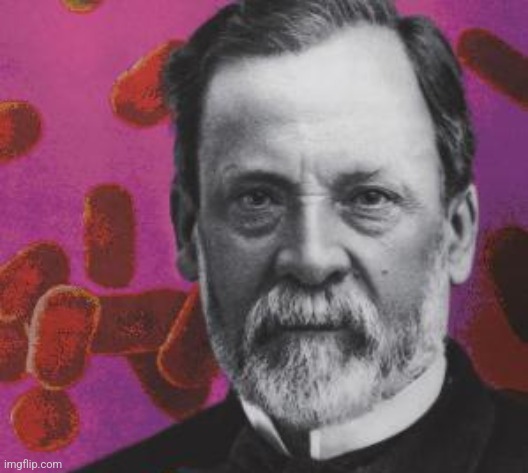
I have provided the most relevant highlights from this paper but I do recommend reading the whole thing sometime as there are passages from Pasteurs own papers and other interesting facts contained within:
Pasteur’s Work On Rabies:
Reexamining the Ethical Issues
Ethical Issues Specific to Rabies
“Rabies has always been rare in man. It probably never claimed more than a hundred victims in any year in France, and Fiench estimates for the years immediately preceding Pasteur’s famous work indicate an annual mortality of considerably less than fifty. In addition, rabies is not an infectious disease in the usual sense; it is not transmitted from man to man. Because of these two features, general or compulsory vaccination has never seemed appropriate with respect to rabies. The potential social benefit has never seemed sufficient to justify the sort of intrusion on individual rights represented by compulsory vaccination against smallpox, for example.”
“An even more peculiar feature of rabies is its long incubation period in the absence of detectable symptoms. No other lethal disease of rapid clinical course even approaches rabies for length of incubation-usually six to eight weeks, but sometimes a year or more. This feature of rabies opened the possibility of a treatment that might be applied after the disease had (presumably) been contracted but before the symptoms became manifest. This is, of course, the hallmark of Pasteur’s rabies “vaccine” and of all succeeding treatments for the disease.
Unfortunately for Pasteur and his successors, there is a very high degree of uncertainty in the correlation between animal bites and the subsequent appearance of rabies-even when the biting animal is certifiably rabid. While the mortality of clinical rabies is virtually 100 percent, the threat of death from the bite of a rabid animal is vastly less. The risk depends on several factors, including the species of attacking animal (wolf and cat bites, for example, pose a much higher risk than dog bites), the location and depth of the bites, and the application or timing of cauterization. Depending on these and other circumstances, estimates of the risk of contracting rabies from the bites of animals known to be rabid range from as high as 80 percent to as low as 0.5 percent. It is perhaps futile to try to settle upon a meaningful “average” figure within this range, but Pasteur himself estimated that 16 percent of those bitten by rabid dogs would eventually die of rabies unless they submitted to his new treatment.
In any case, most victims of rabid animal bites could forego treatment without experiencing any untoward consequences in the future. Since all forms of treatment yet devised or contemplated for rabies are applied before any symptoms become manifest, and since all carry some risk of their own, a special ethical problem is created in the treatment of rabies. To be sure, all therapeutic or preventive measures involve some degree of uncertainty and all carry some risk of harm.”
“If rabies vaccination is therefore unlike ordinary vaccination, so too is it unlike ordinary therapeutic measures. These are undertaken for the immediate sake of an individual in whom disease has already become manifest. As such, they have created relatively few ethical problems-even when they amount to a form of human experimentation. In vaccinating the victim of an animal bite against rabies, by contrast, one can never be sure that the subject
of treatment has in fact contracted the disease. And one can therefore never be sure whether the treatment is even potentially beneficial to him or to anyone else.
If these distinctions now seem overly precious or sophistic, that is only because the accumulated experience of a century suggests that the risk of death or injury from rabies vaccination is appreciably less than the risk of death from the bite of a rabid animal. Because of the overwhelming (if less than perfect) success of the treatment, we have lost sight of the fact that every case of vaccination against rabies is necessarily a form of nontherapeutic human experimentation without potential benefit to society at large.”
A much more troublesome objection for Pasteur had its origin in a very special feature of his work that he himself did much to emphasize. His vaccines, unlike Jenner’s vaccine against smallpox, were products of the laboratory. For Pasteur, this feature of his vaccines represented an important advance; as laboratory products, they were also more susceptible to human manipulation and control than the smallpox vaccine that Jenner took from nature.”‘ But for a few of his critics, notably his leading medical adversaries, this feature of Pasteur’s rabies vaccine raised the appalling possibility that one might now be forced to deal with a novel disease, one that Pasteur himself had created: artificial or laboratory rabies. Not altogether unlike the current opponents of recombinant DNA research, these critics emphasized that Pasteur’s vaccine was an altered virus of somewhat uncertain properties. As evidence that their fear had some basis in reality, they early pointed to the frequency with which the “paralytic” form of rabies seemed to appear after Pasteur’s treatments, as opposed to its alleged rarity under natural conditions. These medical critics also complained that Pasteur’s use of a “live” neurotropic vaccine complicated the difficulty of diagnosis in any vaccinated individual who later developed nervous symptoms. In retrospect, it seems clear that while Pasteur’s critics greatly exaggerated the dangers of his treatment, their critique was not entirely without justification.”
“In the first place, Peter insisted, Pasteur’s work was not properly scientific because he kept the details of his treatment secret. Like all purveyers of empiric remedies, he said both too much and too little about his treatment for rabies-enough to attract acclaim and fiscal returns, but too little to allow independent evaluation of his claims. Nor was this the first time Pasteur had been charged with self-interested secrecy, with behavior more appropriate to a profiteering
technologist than a disinterested seeker after scientific truth. Some had criticized him for taking out patents for his methods of making or preserving beer, wine, and vinegar before publishing the memoirs by which those methods became publicly known. In the early 1880s, his dramatic claims of successful vaccines against chicken cholera and anthrax in sheep provoked charges of improper secrecy. Pasteur’s early accounts of his rabies treatment, through their reticence about the details of the method, invited similar attacks.
To all such charges, Pasteur responded by insisting on the need for careful quality control and by consistently denying that his motives were in any way mercenary. He pointed to the risk of a fatal disaster if the details of his method became known to those less experienced than he and his collaborators, and he reminded his critics that he dispensed his treatment without charge. Eventually, if only eventually, he also revealed the details of his method to a dozen or so scientists and physicians, including several foreigners, who came to his laboratory to learn it first-hand.
Nonetheless, Pasteur’s initial secrecy and reticence helped to inflame a more general debate about whether or not his work on rabies met the standards of truly scientific research.”
“Peter of course denied that Pasteur’s work on rabies was scientific. For one thing, he pointed out, Pasteur had provided no theoretical basis for his treatment. Pasteur was famous for his germ theory of disease, yet he admitted that he had failed to isolate the microbe presumed responsible for rabies. In developing his other vaccines-all for animal diseases-Pasteur had cultivated an attenuated strain of the specific microbe to which he ascribed each disease; his rabies vaccine, by contrast, had been obtained by “empirical” manipulation of rabid spinal cords. Peter might also have asked, though he did not, exactly how Pasteur could explain attenuation, whether in the case of dessicated spinal cords or his other vaccines.
Early on in the debates of 1887, Pasteur blandly asserted that the “scientific basis” of his treatment lay in “the possibility of conferring on animals immunity against the virus of street rabies by the sub-cutaneous injection of increasingly virulent rabbit spinal cords. This was to transform a simple empirical result into a “scientific” foundation for his treatment. Less subtle still was one of his supporters, M. Brouardel, who offered this blatantly utilitarian defense of Pasteur’s treatment:
As to the reproach directed against the method as being anti-scientific, I avow that I do not understand it. By this reckoning, the Jennerian vaccination is even more anti-scientific, for it preserves us from one disease [i.e., smallpox] by giving us another [i.e., cowpox]….
In my opinion, that alone is anti-scientific which is not
true. If one demonstrated to me that rabies could be cured by the use of a fantastic omelette or oyster-shells, I would still find the thing scientific. In the end, those who seek this quarrel with Pasteur simply ask him the how and the why of this method. M. Pasteur will tell us that we have found the answer to the question posed by our great comic [Moliere]: why does opium produce sleep?”
For Peter, such “defenses” of Pasteur’s work perhaps confirmed his darkest suspicions. For him, Pasteur’s study of rabies represented nothing but ’empiricism embellished by contradiction.‘
Animal Experiments and Pasteur’s Initial Human Trials
“Insofar as Peter’s critique consisted of a demand for perfection in science, it obscured a more telling objection to Pasteur’s work-one in which ethical concerns emerge in stark relief. Almost, but not quite, lost in the context of Peter’s overwrought attack was the accusation that Pasteur had applied his treatment to humans without having first established its safety and efficacy in animals. More specifically, charged Peter, Pasteur had failed to establish the safety and efficacy of his treatment for animals after they had been bitten by a rabid dog. His “refractory” (that is, immune) animals had been rendered so only before they were bitten.
To make this charge in 1887, as Peter must have realized, was virtually tantamount to calling Pasteur a liar. From the first, from his famous memoir of 26 October 1885 announcing the application of his rabies treatment to man, Pasteur claimed that he had “already rendered a large number of dogs refractory to rabies after they had been bitten. Peter complained that Pasteur failed to specify what he meant by a “large number” of dogs and that he offered neither details nor proof of his assertion. Even if true, continued Peter, these initial post-bite experiments could scarcely justify the shift from Pasteur’s original method of rabies vaccination to his “intensive” method, which Peter considered positively dangerous and to which he assigned probable responsibility for at least one death among Pasteur’s human subjects. This intensive treatment, alleged Peter, was “purely empirical, or rather it is a question here of a priori experiments practiced on man.” Pharmacologist E.F.A. Vulpian, who had already lent his prestige in support of Pasteur’s work and treatment, expressed his sense of the gravity (if not the accuracy) of Peter’s charges by saying that they amounted to an accusation of “involuntary homicide” against Pasteur and his collaborators.
Until Pasteur’s laboratory notebooks on rabies have been deciphered and subjected to critical scrutiny, we cannot assess the literal accuracy of Peter’s gravest charges against Pasteur. In the meantime, however, we may reasonably harbor doubts about the ethicality of Pasteur’s earliest human trials on the basis of the published record alone. In fact, those doubts can be set aside only if the reader is willing to accept at face value Pasteur’s own vague and excathedra assertions about the safety and efficacy of his method of treatment. To do so would be to ignore, among other things, credible published accounts that several of Pasteur’s own disciples doubted the propriety (or at least the wisdom) of his early human trials. Conspicuous among these defectors was the most penetrating of his collaborators on rabies, Emile Roux, who reportedly refused to sign the first report of treatment.
More significantly still, the careful reader of Pasteur’s later and less famous papers on rabies will discover (in a memoir of November 1886) his own admission that he had not yet, at the time he treated Joseph Meister, established the efficacy of his treatment in the case of animals previously inoculated with rabies in the most decisive way-that is, by the intracranial inoculation of ordinary canine rabies directly onto the dura mater following trepanation. “My first experiments on this point,” wrote Pasteur, “date from the month of August 1885”-a month after he had begun to treat Meister-and even then “success had been but partial.”
Given the rarity of rabies in man, and the consequent necessity of treating it only in the case of persons already bitten by a rabid animal, Pasteur’s admission directs our attention very forcefully to two passages in the memoir of October 26, 1885 by which he announced the application of his treatment to humans. In the first of these two passages, Pasteur claimed that he had already made fifty dogs
immune to rabies, “without having encountered a single failure,” when Meister appeared at his laboratory in July 1885. But Pasteur offered no evidence whatever for this assertion. The reader was left to guess at the details of those absolutely crucial animal experiments. Later in the same memoir, in a passage to which Michel Peter obviously paid close attention, Pasteur wrote as follows:
My fifty dogs, it is true, had not been bitten before I rendered them refractory to rabies, but I knew that this circumstance could be eliminated from my preoccupations, for I had already rendered a large number of dogs refractory to rabies after they had been bitten.”
Quite apart from Peter’s complaint that Pasteur failed to specify what he meant by “a large number” of dogs, a more serious question was also left unanswered in this memoir. Since Pasteur failed to provide any further information about the nature, aims, or details of the experiments in which he had produced immune dogs, it is not even clear whether they had been treated by the same method used to treat Meister-that is, by the daily inoculation of progressively virulent spinal cords.
Oddly, and perhaps significantly, Pasteur never used the results contained in his own laboratory notebooks in defense of his method of treatment. Not even the virulent attacks of Peter and others could induce him to reveal the details of the animal experiments he had performed before treating Meister, and he died a decade later without publishing any further account of them.”
https://doi.org/10.2307/3560403
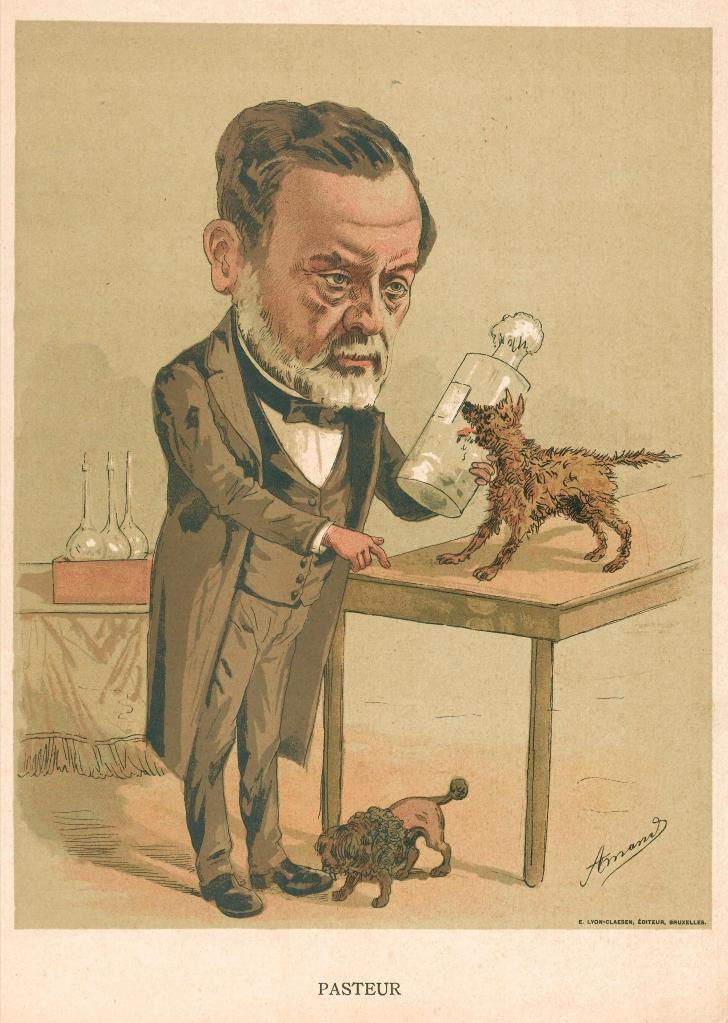
Geison’s account of the character of Pasteur is a damning portrayal of a man more concerned with the fame and the prestige of the “discovery” than adhering to the accepted scientific methods. He was a man who was secretive, manipulative, and unethical; a man who would say one thing and do another. He “massaged” his data to fit his own desired goals. Even his peers were skeptical of his work and the practices he employed. However, Pasteur had powerful friends backing him which drowned out the opposition and ultimately led to his unscientific theories being accepted as the Germ Theory we have today.
While Geison’s work is an invaluable look into the character and work ethic of a madman, he also provided plenty of evidence against Pasteur’s rabies research. As Pasteur admitted that he never isolated any microbe capable of causing rabies, everything he did to combat the disease was based on nothing but pure guesswork. Pasteur assumed that the causative agent was within the spinal cord emulsions he injected into the brains of other animals even though he could not find one there. As in the case of every “virus,” Pasteur had no independent variable (i.e. purified and isolated particles) for which he could use in order to establish cause and effect. He could not prove any pathogenic agent was in his inoculations. However, as Geison pointed out, there was a neurotropic agent within his injectable concoction and as his vaccines were products of the laboratory, this raised the very realistic possibility that the disease seen after vaccination was one Pasteur himself had created: artificial or laboratory rabies. Seeing as rabies was rare in man and that most cases were symptomless and/or recovered without treatment, was rabies nothing more than a vaccine-created disease?
A paper from 1951 provides evidence that this is exactly what has occurred. After the use of Pasteur’s rabies vaccine became more widespread, the literature began to pile up regarding severe reactions, including fatalities, after treatment. The reactions were broken down into two types: those that were extraneural (not involving the nervous system) and those that were neural (involving the nervous system). Even Joseph Meister, the boy Pasteur “cured” of rabies, was said to have had extraneural symptoms throughout the course of his treatment. The mortality of those who experienced neural effects was estimated at 40%. There were two different theories as to why these reactions occurred. The first theory was that it was a toxic reaction to the nerve tissue used in the preparations. The second theory assumed a “virus.” Interestingly in the case of the assumed “virus,” there were similarities in the microscopic and gross pathology of rabies vaccine encephalomyelitis, “true” rabies and nonvaccinal encephalomyelitis complicating smallpox. Some researchers even found that measles, smallpox and antirabies vaccination had clinical and pathological resemblances in the neurological complications of the diseases:
NEUROLOGICAL COMPLICATIONS OF RABIES VACCINE
“WHEN Louis Pasteur1 successfully prevented the appearance of rabies in Joseph Meister (1885) following the bite of a rabid dog, new hope was offered to persons who previously would have been condemned to certain death. However, in the years that followed it became apparent that the use of rabies vaccines was not without risk. Reports of various reactions, some fatal, began to accumulate in the literature, and the etiologic factors in these complications became a subject of dispute, which continues until the present day, some 64 years after the development of Pasteur’s treatment.”
GENERAL CONSIDERATIONS
Reactions to antirabies therapy have been completely described and classified by Horack. His seven groups may be combined under two main heads: the extraneural and the neural type. Extraneural complications, which do not primarily involve the nervous system, are of two types:
- The appearance in sensitized persons soon after the institution of treatment of a generalized urticarial rash, which responds to epinephrine.
- Local reactions, with or without systemic involvement, varying from simple redness, swelling and induration at the site of injection to a severe local response, attended with headache, malaise, fever and lymphadenopathy. It is entirely possible that Joseph Meister had this type of reaction under Louis Pasteur’s treatment, since Vallery-Radott quotes Pasteur’s observations on the child:
The last three inoculations have left some pink marks under the skin, gradually widening and not at all tender. There is some action, which is becoming more intense as we approach the final inoculation, which will take place on Thursday, July 16.
The neural type of reaction, affecting the nervous system, usually falls under one of three forms:
- The peripheral form, commonly involving the facial nerve. Complete recovery is usual.
- The spinal form, occurring after a preliminary severe local reaction and manifesting itself either as dorsolumbar myelitis, with paresthesias, sphincter disturbance and paralysis of the lower extremities, or as an ascending paralysis of the Landry type.
- The cerebral form, without paralysis, characterized by a prodrome of adenopathy, malaise, headache and inflammation at the site of injection and the subsequent development of drowsiness, nuchal rigidity and signs of increased intracranial pressure, i. e., bradycardia and papilledema.
The incidence of neuroparalytic accidents complicating the use of rabies vaccine has been variously reported by American authors as ranging from 1: 280 treated patients, in a small series, to 1:8,287 patients receiving the vaccine (table 1).
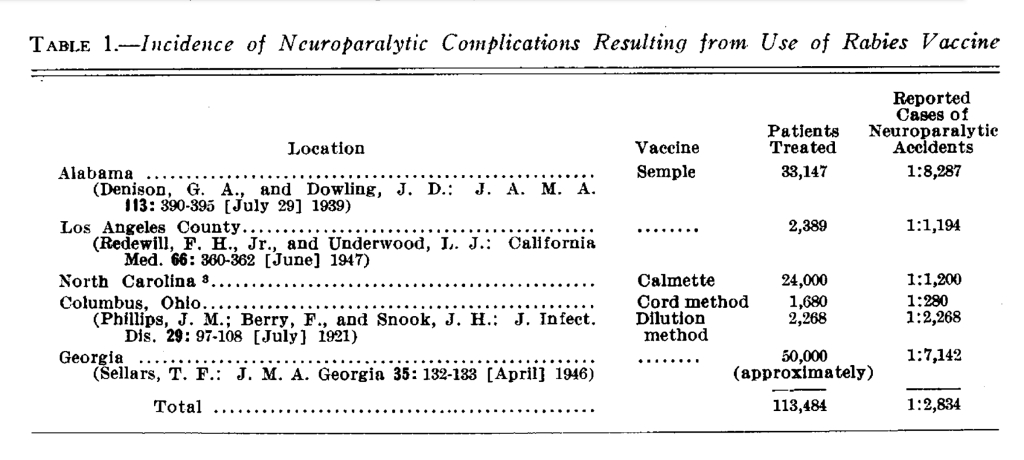
On the other hand, worldwide statistics, reported by Greenwood, place the incidence at 1: 5,814 in a series of 1,290,758 treated patients, with a mortality of 25 percent.
In 22 cases of neurological reactions to rabies vaccine collected from the literature the large majority of the patients were between 20 and 40 years of age, and the males outnumbered the females by more than 2:1. The mortality in this group was 40 percent.
In Michigan, approximately 6,000 patients received 84,122 doses of rabies vaccine from July 1, 1945 through March 31, 1949. During this period, 12 cases of reactions of all types to rabies vaccine, including four cases of neuroparalytic accident with one death, were reported to the Michigan Department of Health. This represents 1 case of postvaccinal involvement of the nervous system for 1,500 patients treated (table 2).
Of the many theories concerning the etiology of reactions to antirabies treatment, those with current support may be divided into two groups: those which implicate the nerve tissue in the vaccine as the causative agent and those which assume a culpable virus.
Proponents of the former hold that the reactions are due to the toxic effect of a constituent of nerve tissue in the inoculant on the nervous system of the recipient, or that they are anaphylactic or allergic responses to repeated injection of nerve proteins in the vaccine. It is the belief of Stuart and Krikorian that the accidents are due to the injected brain tissue, and they postulate the presence of a “cytotoxin” in normal brain tissue. To support their views, they offer experimental studies with animals in which paralyses were produced by the injection of both homologous and heterologous normal brain substance. They concede, however, that an individual idiosyncrasy on the part of the patient may be important. On the other hand, Hurst concludes from his investigations that the evidence is insufficient to prove that the injected brain tissue per se is responsible for the syndrome.
Schwentker and Rivers; Kabat, Wolf and Bezer, and Morrison state that their laboratory researches have led them to believe that a serologie response, the production of antibodies against an antigen, takes place to the injection of emulsions of nerve tissue. Kirk and Ecker, in transposing the work to human subjects, report that they found an increased antibrain antibody titer in the serum of a patient in whom encephalitis developed after antirabies therapy. These findings lend credence to the theory that reactions to rabies vaccines are anaphylactic or allergic. Horack reports that the incidence of a personal or a familial history of allergy was significantly greater in a group of patients who exhibited reactions to rabies vaccine than in a control group who tolerated the injections without complication. It cannot be denied that anaphylactic reactions to the prophylactic use of rabies vaccine do occur. Dorfman describes one case in which a syncopal attack with a pseudopodial wheal and generalized urticaria appeared within a short time after the injection of Semple vaccine. Epinephrine was administered, and the symptoms disappeared. It was proved that the patient was hypersensitive to rabbit dander.”
“Another group of investigators subscribe to the hypothesis that the reactions to the vaccine are caused by a virus. Bassoe and Grinker conclude that the fixed virus present in the inoculum is responsible. They base their deductions on similarities in the microscopic and gross pathology of rabies vaccine encephalomyelitis, true rabies and nonvaccinal encephalomyelitis complicating smallpox. While filtering phenolized vaccines through a wire sieve, Kelser 20 recovered some relatively coarse particles, which were suspended in saline solution and injected intracerebrally into rabbits. Fixed virus rabies was produced in these animals. It is his contention that phenolizing the vaccine “seared” the particles and protected the virus in the deeper portions. Therefore, he reasons, viable fixed virus can, and often does, become pathogenic.
Babonneix and Sigwald postulate that the fixed virus in the vaccine activates a latent micro-organism present in the nervous system of the recipient of the vaccine. They draw a parallel between this action and that of the virus in smallpox vaccine, which, according to Levaditi and Nicolai, sensitizes the nervous system of the person inoculated to the virus of herpes encephalitis.
Marsden and Hurst believe that measles, smallpox and antirabies vaccination are predisposing factors to an independent exanthem, which they term “acute perivascular myelinoclasis.” As proof, they cite observed clinical and pathological resemblances in the so-called neurological complications of these diseases.”
doi:10.1001/archneurpsyc.1951.02320010022002

This is not the only study providing evidence that the rabies vaccine caused the neurological symptoms associated with the disease. Here are some short snippets from other studies throughout the years highlighting similar findings:
From 1960:
NEUROLOGICAL COMPLICATIONS OF ANTIRABIES VACCINE
“Neuroparalytic complications occur in 1 of every 287 to 1 of every 8,287 persons receiving the Pasteur antirabies vaccine. Greenwood found an over-all incident of one reaction to 5,814 treatments on a world-wide basis in a total series of 1,297,758 treated patients. In the same series, there were 56 fatalities, equivalent to 25% mortality in those suffering a neuroparalytic complication. Latimer and co-workers reported 40% mortality in 22 cases of neurological complication reported in the literature. A rabies vaccine prepared from virus grown on duck embryo is now available from commercial sources. This preparation will materially reduce the use of vaccine prepared from rabbit central nervous system. However, certain persons may not be able to tolerate the avian embryo vaccine, so it seems unlikely that the rabbit central nervous system preparation (Pasteur vaccine) will fall into complete disuse.”
https://jamanetwork.com/journals/jama/article-abstract/328831
From 1988:
A high rate of neurological complications following Semple anti-rabies vaccine
“A fatal case of encephalitis due to Semple (phenolized sheep-brain) anti-rabies vaccine prompted a search for neurological complications among 722 recipients of 2 vaccine batches administered in Bangkok, Thailand in June and July 1984. A review of all patients admitted with neurological symptoms from June through August 1984 to the 5 major teaching hospitals in Bangkok found 6 cases (0·83%), including the index case, who had received the vaccine. Rabies infection was ruled out in all 6 cases. 4 patients had meningitis, and 2 had meningo-encephalitis.”
https://www.sciencedirect.com/science/article/abs/pii/0035920388901678
From 1996:
Neurological complications in adults following rabies vaccine prepared from animal brain
“Conclusion: Semple-type adult animal nerve tissue vaccine produces an unacceptable rate of severe post-vaccinal neurological complications in adults. Human diploid cell rabies vaccine should be used for post-exposure rabies vaccination.”
https://pubmed.ncbi.nlm.nih.gov/8685108/
From 2003:
Neurological complications of rabies vaccines
“The rabies vaccines containing neural elements are used in some countries including India. We report three cases that presented with various neurological complications following the use of these vaccines. The presenting manifestations included those of encephalitis, radiculitis and acute inflammatory demyelinating polyradiculoneuropathy. These neurological complications are highlighted so that scientific evidence compels the community to discontinue the use of the neural tissue rabies vaccines. Newer generation cell culture rabies vaccines should be preferred over the neural tissue rabies vaccines for post-exposure prophylaxis.”
https://pubmed.ncbi.nlm.nih.gov/12626831/
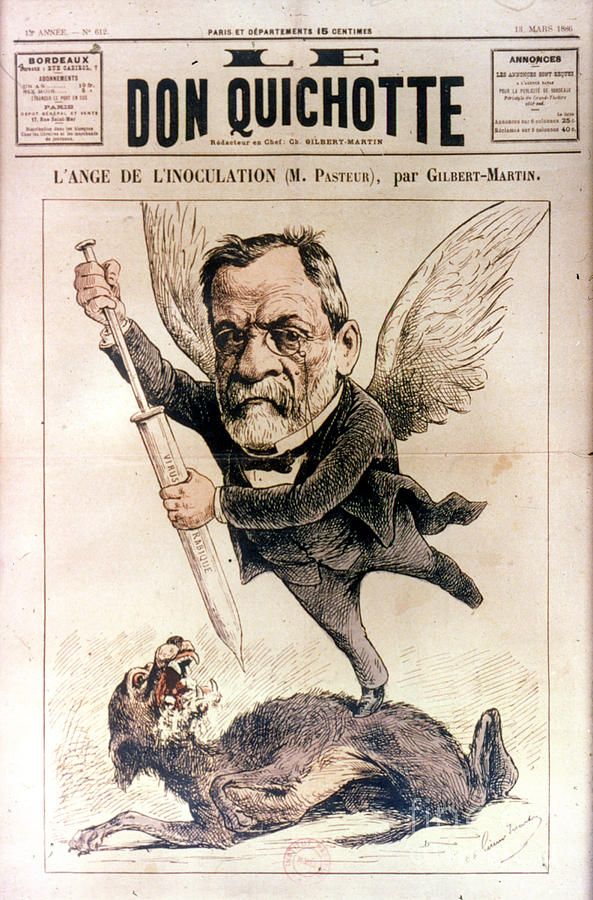
In Summary:
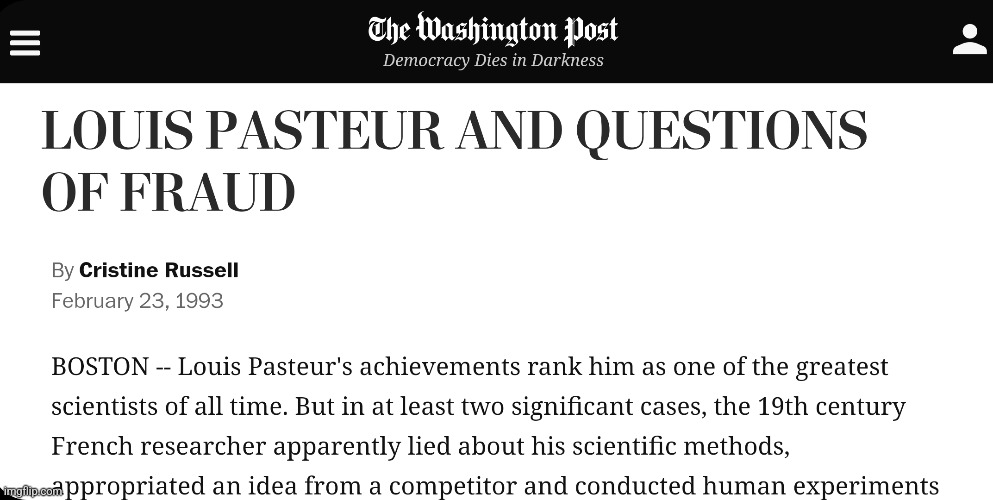
- In at least two significant cases, Louis Pasteur lied about his scientific methods
- He appropriated an idea from a competitor and conducted human experiments that would be considered unethical then as well as today
- Gerald L. Geison, a leading Pasteur scholar concluded that Pasteur would “not have passed muster with Congress” if his scientific methods were scrutinized today
- He carefully instructed his family never to show his journals to anyone
- Geison eventually found “ethically dubious conduct” in Pasteur’s famous anthrax and rabies vaccines
- Pasteur impulsively accepted a public challenge to demonstrate its effectiveness of his anthrax vaccine, despite the private consternation of his own colleagues and his own inner doubts that his vaccine was really ready for use
- According to a footnote in one of his lab notebooks, in the challemge Pasteur had used a different vaccine approach than the one he promoted in which the anthrax was treated with chemicals to weaken it rather than being exposed to oxygen
- Pasteur “pushed aside a rival,” Jean-Joseph Henri Toussaint, an obscure veterinarian who developed the chemically treated vaccine first and had visited Pasteur’s laboratory to discuss it
- According to Geison, “Pasteur deliberately deceived the public and scientific community about the precise nature of the vaccine he used,” said Geison, calling it a “clear case of scientific misconduct . . . He knew full well he was lying.”
- Pasteur used his rabies vaccine on 9-year-old Joseph Meister and three months later he published a paper reporting that his rabies vaccine had previously been tested on 50 dogs without a single failure before he used it to treat the boy
- But Geison discovered through the notebooks that this was, “to put it charitably, a very misleading account”
- Pasteur had extensively tested a vaccine on dogs that used an approach that was exactly the reverse of the one used on Meister
- Pasteur had no conclusive animal results to show that the technique worked
- There was no experimental evidence for his published claims about the extent of the safety and efficacy of the vaccine in animals before the human rabies trial
- Pasteur’s message for contemporary science, Geison argued, was to puncture the “hopelessly misleading” image of science as “simply objective and unprejudiced,” a myth that scientists have perpetuated in order to advance their work and attain a “privileged status
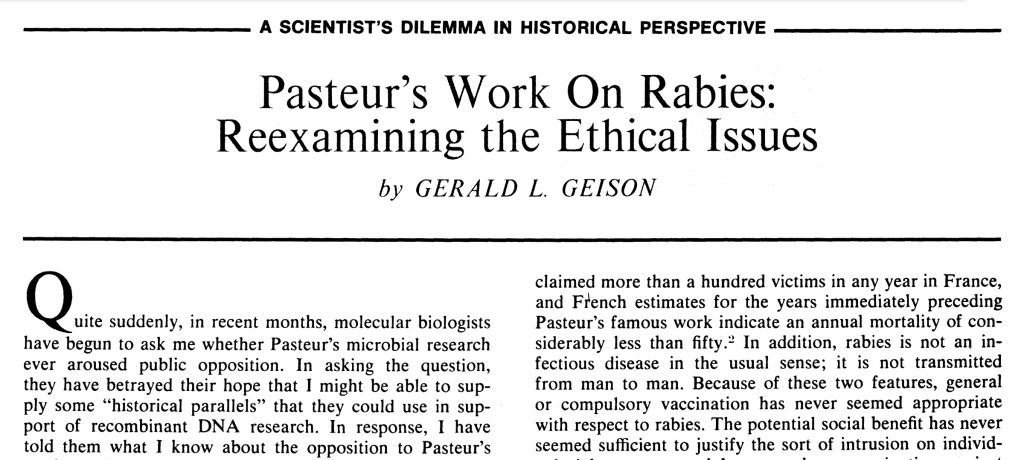
- Rabies has always been rare in man
- Rabies is not an infectious disease in the usual sense; it is not transmitted from man to man
- Because of these two features, general or compulsory vaccination has never seemed appropriate with respect to rabies
- A peculiar feature of rabies is its long incubation period in the absence of detectable symptoms
- No other lethal disease of rapid clinical course even approaches rabies for length of incubation-usually six to eight weeks, but sometimes a year or more
- Unfortunately for Pasteur and his successors, there is a very high degree of uncertainty in the correlation between animal bites and the subsequent appearance of rabies-even when the biting animal is certifiably rabid
- While the mortality of clinical rabies is virtually 100 percent, the threat of death from the bite of a rabid animal is vastly less
- The risk depends on several factors including:
- The species of attacking animal (wolf and cat bites, for example, pose a much higher risk than dog bites)
- The location and depth of the bites
- The application or timing of cauterization
- Estimates of the risk of contracting rabies from the bites of animals known to be rabid range from as high as 80 percent to as low as 0.5 percen
- It is perhaps futile to try to settle upon a meaningful “average” figure within this range, but Pasteur himself estimated that 16 percent of those bitten by rabid dogs would eventually die of rabies unless they submitted to his new treatment
- Most victims of rabid animal bites could forego treatment without experiencing any untoward consequences in the future
- To be sure, all therapeutic or preventive measures involve some degree of uncertainty and all carry some risk of harm
- In vaccinating the victim of an animal bite against rabies, one can never be sure that the subject of treatment has in fact contracted the disease
- One can therefore never be sure whether the treatment is even potentially beneficial to him or to anyone else
- Every case of vaccination against rabies is necessarily a form of nontherapeutic human experimentation without potential benefit to society at large
- Pasteur’s vaccines, unlike Jenner’s vaccine against smallpox, were products of the laboratory
- This feature of Pasteur’s rabies vaccine raised the appalling possibility that one might now be forced to deal with a novel disease, one that Pasteur himself had created: artificial or laboratory rabies
- As evidence that their fear had some basis in reality, critics early pointed to the frequency with which the “paralytic” form of rabies seemed to appear after Pasteur’s treatments, as opposed to its alleged rarity under natural conditions
- These medical critics also complained that Pasteur’s use of a “live” neurotropic vaccine complicated the difficulty of diagnosis in any vaccinated individual who later developed nervous symptoms
- Pasteur’s work was not properly scientific because he kept the details of his treatment secret
- He said both too much and too little about his treatment for rabies-enough to attract acclaim and fiscal returns, but too little to allow independent evaluation of his claims
- In the early 1880s, his dramatic claims of successful vaccines against chicken cholera and anthrax in sheep provoked charges of improper secrecy
- Pasteur defended himself by pointing to the risk of a fatal disaster if the details of his method became known to those less experienced than he and his collaborators
- Pasteur’s initial secrecy and reticence helped to inflame a more general debate about whether or not his work on rabies met the standards of truly scientific research
- Pasteur had provided no theoretical basis for his treatment
- Pasteur was famous for his germ theory of disease, yet he admitted that he had failed to isolate the microbe presumed responsible for rabies
- His rabies vaccine had been obtained by “empirical” manipulation of rabid spinal cords
- Pasteur blandly asserted that the “scientific basis” of his treatment lay in “the possibility of conferring on animals immunity against the “virus” of street rabies by the sub-cutaneous injection of increasingly virulent rabbit spinal cords
- M. Brouardel, a supporter of Pasteur’s, stated: “As to the reproach directed against the method as being anti-scientific, I avow that I do not understand it. By this reckoning, the Jennerian vaccination is even more anti-scientific, for it preserves us from one disease [i.e., smallpox] by giving us another [i.e., cowpox]….“
- For another critic of Pasteur, his rabies work represented nothing but ’empiricism embellished by contradiction.’
- Pasteur applied his treatment to humans without having first established its safety and efficacy in animals
- Pasteur failed to establish the safety and efficacy of his treatment for animals after they had been bitten by a rabid dog
- His “refractory” (that is, immune) animals had been rendered so only before they were bitten
- Pasteur claimed that he had already rendered a large number of dogs refractory to rabies after they had been bitten yet Peter complained that Pasteur failed to specify what he meant by a “large number” of dogs and that he offered neither details nor proof of his assertion
- Peter stated that even if Pasteur’s claims were true (they weren’t) these initial post-bite experiments could scarcely justify the shift from Pasteur’s original method of rabies vaccination to his “intensive” method, which Peter considered positively dangerous and to which he assigned probable responsibility for at least one death among Pasteur’s human subjects
- Peter’s charges amounted to an accusation of “involuntary homicide” against Pasteur and his collaborators
- Geison stated that until Pasteur’s laboratory notebooks on rabies have been deciphered and subjected to critical scrutiny, we cannot assess the literal accuracy of Peter’s gravest charges against Pasteur (fortunately, we now know these charges were determined to be true after Geison went through the notebooks)
- There are credible published accounts that several of Pasteur’s own disciples doubted the propriety (or at least the wisdom) of his early human trials
- Conspicuous among these defectors was the most penetrating of his collaborators on rabies, Emile Roux, who reportedly refused to sign the first report of treatment
- Pasteur’s later and less famous papers on rabies (in a memoir of November 1886) contains his own admission that he had not yet, at the time he treated Joseph Meister, established the efficacy of his treatment in the case of animals previously inoculated with rabies in the most decisive way-that is, by the intracranial inoculation of ordinary canine rabies directly onto the dura mater following trepanation
- Pasteur claimed that he had already made fifty dogs immune to rabies, “without having encountered a single failure,” when Meister appeared at his laboratory in July 1885 yet Pasteur offered no evidence whatever for this assertion
- Pasteur also wrote in the same memoir: “My fifty dogs, it is true, had not been bitten before I rendered them refractory to rabies.”
- Pasteur failed to provide any further information about the nature, aims, or details of the experiments in which he had produced immune dogs
- It is not even clear whether they had been treated by the same method used to treat Meister-that is, by the daily inoculation of progressively virulent spinal cords
- Pasteur never used the results contained in his own laboratory notebooks in defense of his method of treatment
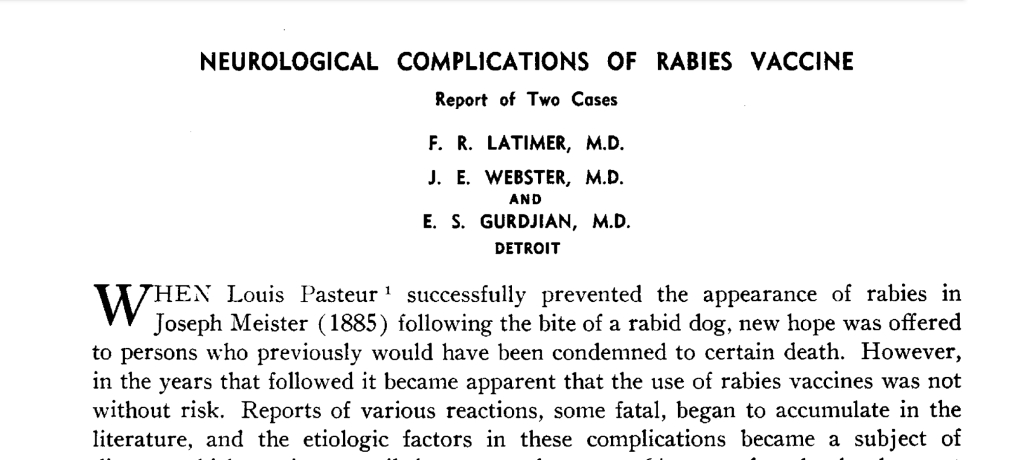
- In the years that followed Pasteur’s vaccination of Joseph Meister, it became apparent that the use of rabies vaccines was not without risk
- Reports of various reactions, some fatal, began to accumulate in the literature, and the etiologic factors in these complications became a subject of dispute
- There are two types of rabies vaccination injuries: those that are extraneural and those that are neural type:
- Extraneural
- A generalized urticarial rash
- Local reactions, with or without systemic involvement, varying from simple redness, swelling and induration at the site of injection to a severe local response, attended with headache, malaise, fever and lymphadenopathy.
- It is believed Joseph Meister may have suffered extraneural symptoms
- Neural
- The peripheral form, commonly involving the facial nerve. Complete recovery is usual.
- The spinal form, occurring after a preliminary severe local reaction and manifesting itself either as dorsolumbar myelitis, with paresthesias, sphincter disturbance and paralysis of the lower extremities, or as an ascending paralysis of the Landry type.
- The cerebral form, without paralysis, characterized by a prodrome of adenopathy, malaise, headache and inflammation at the site of injection and the subsequent development of drowsiness, nuchal rigidity and signs of increased intracranial pressure, i. e., bradycardia and papilledema.
- Extraneural
- The incidence of neuroparalytic accidents complicating the use of rabies vaccine has been variously reported by American authors as ranging from 1: 280 treated patients, in a small series, to 1:8,287 patients receiving the vaccine
- There were two camps of theories for these adverse reactions:
- Those which implicate the nerve tissue in the vaccine as the causative agent
- Those which assume a culpable “virus”
- Proponents of the former hold that the reactions are due to the toxic effect of a constituent of nerve tissue in the inoculant on the nervous system of the recipient, or that they are anaphylactic or allergic responses to repeated injection of nerve proteins in the vaccine
- It is the belief of Stuart and Krikorian that the accidents are due to the injected brain tissue, and they postulate the presence of a “cytotoxin” in normal brain tissue
- Schwentker and Rivers; Kabat, Wolf and Bezer, and Morrison state that their laboratory researches have led them to believe that a serologie response, the production of antibodies against an antigen, takes place to the injection of emulsions of nerve tissue
- It cannot be denied that anaphylactic reactions to the prophylactic use of rabies vaccine do occur
- Dorfman describes one case in which a syncopal attack with a pseudopodial wheal and generalized urticaria appeared within a short time after the injection of Semple vaccine
- Epinephrine was administered, and the symptoms disappeared and it was proved that the patient was hypersensitive to rabbit dander
- Bassoe and Grinker conclude that the fixed “virus” present in the inoculum is responsible and base their deductions on similarities in the microscopic and gross pathology of rabies vaccine encephalomyelitis, true rabies and nonvaccinal encephalomyelitis complicating smallpox
- While filtering phenolized vaccines through a wire sieve, Kelser recovered some relatively coarse particles, which were suspended in saline solution and injected intracerebrally into rabbits
- Fixed “virus” rabies was produced in these animals
- Babonneix and Sigwald postulate that the fixed “virus” in the vaccine activates a latent micro-organism present in the nervous system of the recipient of the vaccine
- Marsden and Hurst believe that measles, smallpox and antirabies vaccination are predisposing factors to an independent exanthem, which they term “acute perivascular myelinoclasis”
- As proof, they cite observed clinical and pathological resemblances in the so-called neurological complications of these diseases
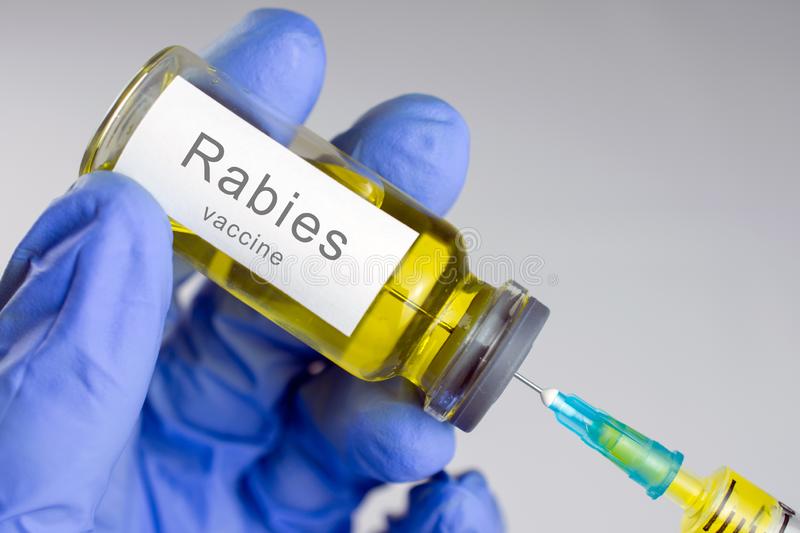
- A study in 1960 fpund that neuroparalytic complications occur in 1 of every 287 to 1 of every 8,287 persons receiving the Pasteur antirabies vaccine
- Fatalities ranged from 25% to 40% mortality in those suffering a neuroparalytic complication
- A rabies vaccine prepared from “virus” grown on duck embryo was created to materially reduce the use of vaccine prepared from rabbit central nervous system
- A study in 1988 looked into a fatal case of encephalitis due to Semple (phenolized sheep-brain) anti-rabies vaccine which prompted a search for neurological complications
- They reviewed all patients admitted with neurological symptoms from June through August 1984 to the 5 major teaching hospitals in Bangkok found 6 cases (0·83%), including the index case, who had received the vaccine
- Rabies infection was ruled out in all 6 cases
- 4 patients had meningitis, and 2 had meningo-encephalitis
- A study in 1996 found that Semple-type adult animal nerve tissue vaccine produces an unacceptable rate of severe post-vaccinal neurological complications in adults
- A study in 2003 looked into the rabies vaccines containing neural elements which are used in some countries including India
- They reported three cases that presented with various neurological complications following the use of these vaccines
- The presenting manifestations included those of encephalitis, radiculitis and acute inflammatory demyelinating polyradiculoneuropathy.
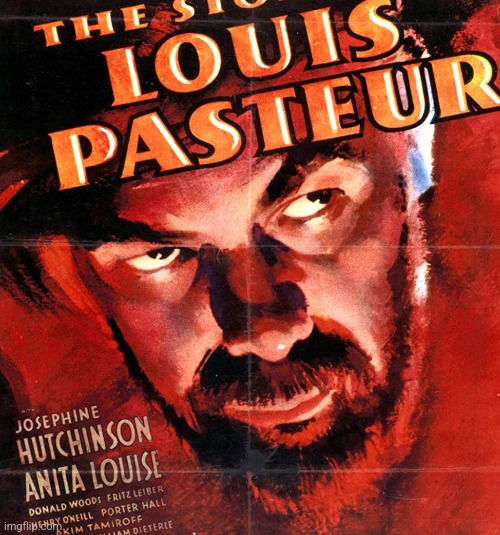
Gerald Geison offered the world a look at the character of Louis Pasteur, the man credited as the Father of Germ Theory, and it was not a flattering portrayal. That it was provided by a leading Pasteur researcher who had access to his private notebooks, which were meant to remain hidden, definitely lends credibility to the claims. The portrayal of this highly flawed man falls in line with the critiques of his contemporaries. The fact that the evidence of Pasteur’s unethical, manipulative, and unscientific methods came from his own hand is poetic justice.
If a man is considered dishonest and untrustworthy, the work he produced should be seen in that same light. The fact of the matter is that Pasteur fixed his own data to fit his scientific ambitions. He was unsuccessful in isolating any causative agent of a disease known to be rare in man and one in which treatment was found to be unnecessary in the majority of the cases. Symptoms and fatalities were rare even in cases of confirmed rabies attack. The use of the rabies vaccine is as a prophylactic in order to stop the potential of symptoms. However, the vaccine has been shown to produce the exact same symptoms. As with the smallpox and polio vaccines, this is yet another obvious case where the vaccine created the very disease it was meant to protect against which has perpetuated the myth that a rabies “virus” exists in the first place.
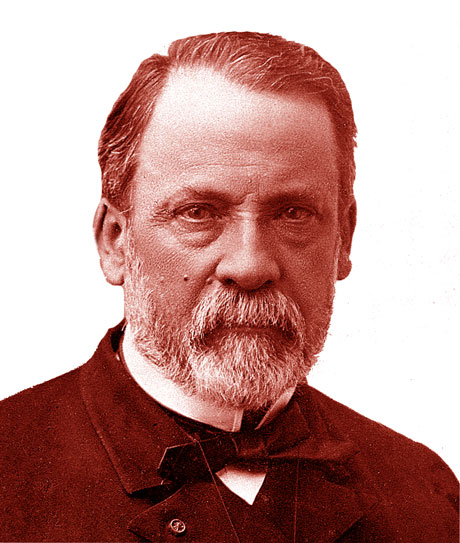
thanks! ❤
LikeLiked by 1 person
You are very welcome! 🙂
LikeLike
I enjoyed yesterday’s video. Seems like the entire medical cabal is built upon lie after lie. You could say that big pharma’s foundation has been “pasteurized” and that it’s a completely faulty foundation. Money never buys truth, but sells lie after lie for profit. Thanks for the story, but I am sick of reading about this bum.
LikeLiked by 1 person
Lol, I understand. I am sick of all of the bums associated with these lies. 😉
LikeLike
Now, how we make sure Dr. Wodarg reads it and more importantly understands it?
LikeLiked by 1 person
Sadly, I don’t think he intends to nor wants to understand any of this.
LikeLike
Oh man I’m feeling so smug right about now. I called this one a couple of years ago. The UK used to be so strict on pets coming into the country from mainly the continent. Yet on the continent it never seemed like it was over run with rabid animals. In fact pets leaving the UK used to get quarantined on the continent. Then all of a sudden it didn’t seem to matter anymore. I remember seeing a particularly terrifying TV programme when I was a kid with a man in a hospital bed sweating and gasping for water but being aqua-phobic at the same time. When I reflected on it was an adult I thought….. Bullshit. Turns out I was right.
LikeLiked by 1 person
Yes, the propaganda sold us very well with rabies. I remember the movies Old Yeller and Cujo and how they cemented the fear of rabies in many including myself. Even the book “To Kill A Mockingbird” has Atticus Finch shoot a rabid dog in the street. We were sold a lie through the media of a manufactured disease created by a toxic injection.
LikeLike
Finally finished reading this fantastic post. I have Geison’s book downloaded as a .PDF. Maybe I can take it off my “To read” list because you have done such a great job here on ViroLIEgy? When I hear “rabies” I always think of Atticus shooting that dog in the street. Unlike that mad dog, some things seem impossible to kill. Germ theory being one of them.
LikeLiked by 1 person
Thanks Lynn! That same scene from “To Kill A Mockingbird” always pops into my head as well. It was great programming on their part. Time to deprogram. 😉
LikeLiked by 1 person
I want to share a brief critique of Louis Pasteur’s rabies “cure” by Thomas Dolan:
https://archive.org/details/jstor-1766935
M. Pasteur and Hydrophobia
By Thomas M Dolan, “The Contemporary Review” and “Science”, 1890
I also want to share a document that I created that critiques the “germ theory of disease causation”:
https://www.questionuniverse.com/germs_disease_fraud.html
Germs Can Not & Do Not Cause Dis-ease: The “germ theory of disease causation” is a Fraud
By Irucka Embry
Thank you.
Irucka Embry
LikeLiked by 1 person
Thank you for sharing! I will give them both a read. 🙂
LikeLike
You are so welcome Mike! Sounds great to me.
Thank you.
LikeLiked by 1 person
Another great article . Thanks.
Have read the book Beauchamp vs Pasteur a few years ago and still learned a lot .
Also looked up the article mentioned in the video put out by Projekt Immanuel.
Considering that it was from the German Doctors magazine 2010 and claimed as science. Unbelievable what Pasteur claimed to be a vaccine that protects against rabies and the medical ‘experts’ of today still applaud such totally antiscientific nonsense based on cruel and gruesome experiments on animals.
It seem the medical field is full of experts in BS – ology including people in the ‘freedom’ camp who claim they are not anti-vaxx and how vaccines were the best thing for humans.
Just the covid injections are the killer shots but it should be given to elderly and vulnerable (for a non existent virus , ) and some even recommended eg. Barrington declaration it was ok to isolate the elderly .
They are either totally incompetent as scientist, cowards or have vested interests.
———
deepL translate slide from – https://t.me/projekt_immanuel/99
“This inoculated the saliva of rabid dogs into a number of animal species, such as chickens, rabbits and dogs, and was thus able to cause the disease in them as well. This proved the transmissibility of an infectious agent, regardless of its effect (60 years before Robert Koch discovered the anthrax pathogen). […]”
*inoculate inoculate
the deliberate, manual introduction of bodily fluids from one organism to another is presented as evidence of transmissibility.
⸻⸺
”He obtained brain matter from a dog that died of rabies. […]. Then he administered the suspension submeningeally to several rabbits, which then died of rabies [… This finally proved that the rabies pathogen […] affects the nervous system. Now Pasteur administered the liquid (presumably) containing the pathogen directly intracerebrally to a dog, which also resulted in death from rabies after 14 days. *Suspension liquid containing fragments of a solid substance swim “submeningeat under the cerebral cavity **intracerebral into the brain.”
“Bizarre, cruel torture, which in itself must inevitably lead to the death of the test animals, is considered scientific evidence of a pathogen”
Article and some links.
https://media2-production.mightynetworks.com/asset/38500367/History_of_Medicine__Louis_Pasteur__Joseph_Meister_and_the_Rabies_.pdf?_gl=1*nnfcbv*_ga*MTIzMTkzOTQ4OC4xNjI1NzM1OTcw*_ga_T49FMYQ9FZ*MTY1MDcxMjgzOS44OTIuMS4xNjUwNzEyODUzLjA.
LikeLiked by 1 person
Thanks for the article and links! It is insane what has passed as science, especially in virology. It absolutely is nothing but the cruel torture of animals in order to sell toxic cures to the clueless populace.
LikeLike
Hi Mike, I’ve read most of Geison’s book. One line on Rabies hit me, “most of the rabid dogs had wood chips and straw in their stomach”. That smelled suspicious to me. I know many plants and trees are poisonous to dogs. I think the mix of these woods and plants along with canine intestinal juices could easily make a neurotoxin. In fact, the long incubation time sounds more like a nerve toxin than a virus supposedly replicating at fantastic speed. Couldn’t find any definitive info.
FYI, your substack is on my substack recommended list, and I’m one of Chirstine’s FOI contributors. Keep going Mike!
LikeLiked by 1 person
Thanks so much for the support ProtonMagic and for helping Christine! I haven’t finished Geison’s book yet but that is very interesting. I definitely believe that these symptoms were some kind of environmental cause, most likely a poisoning of some kind. It could easily have come from what the dogs ate as well as if any pesticides or other toxins were used on or near what they ate.
LikeLike
This site https://therabiesvirus.weebly.com/history.html
says Rabies was rampant in the Roman Empire, toxins still possible, pigments etc. but insecticides which are popular reasons for chemical companies to make up viruses like polio seem less likely. I can’t get Geison’s line about what was in the rabid dogs’ stomachs out of my head, it was just like mentioned in passing with no follow up..https://treesbyjake.com/trees-that-are-dangerous-to-pets/
LikeLiked by 1 person
In your research did you find any information to back up the claim that Pasteur gave known toxic substances to his subjects to ensure that they got sick to “prove” contagion?
Are there actual copies of Pasteur’s notebooks that we can review or do only have Geison’s evaluation to review?
Thanks in advance!
LikeLiked by 1 person
I’m not positive on either account. I heard that Pastuer mixed arsenic with antrax but I haven’t looked into that claim enough. I wouldn’t put it past him as, from most accounts, he was interested in fame, fortune, and prestige. Pasteur was a fraud.
As for his notebooks, the closest I know is the book by Gerald Geison linked at the end of this article with an attached PDF version:
https://mikestone.substack.com/p/all-terrain
LikeLike